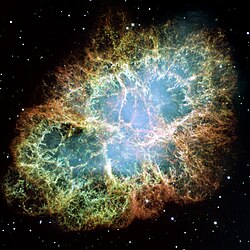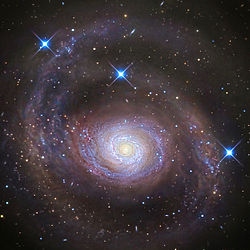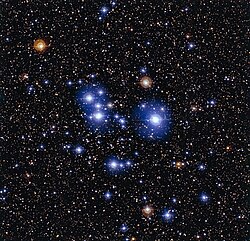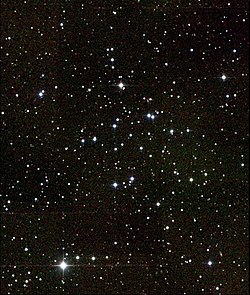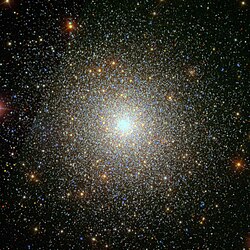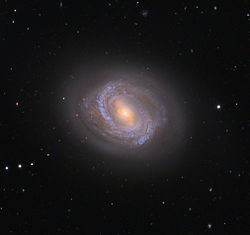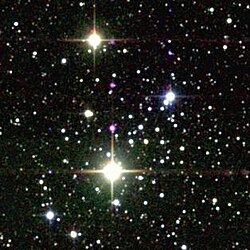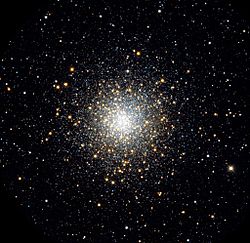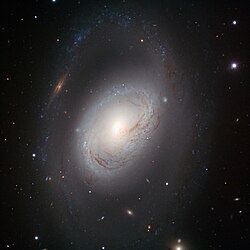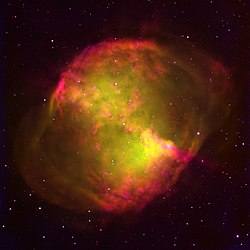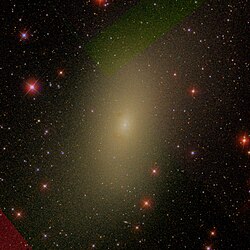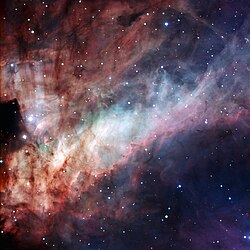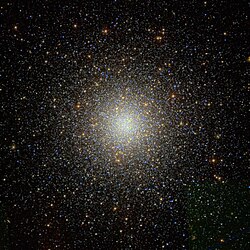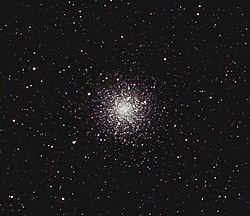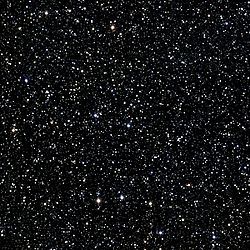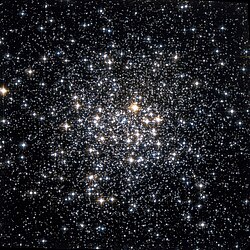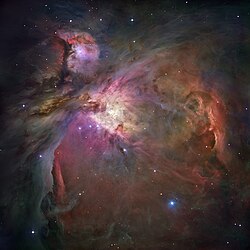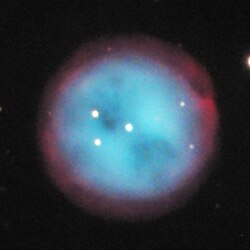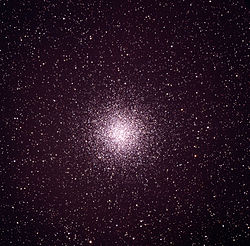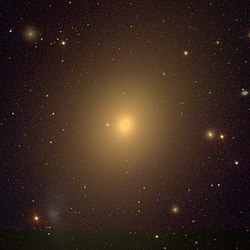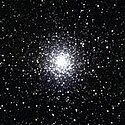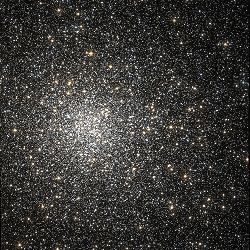Messier-Katalog
Der Messier-Katalog ist eine Auflistung 110 ortsfester astronomischer Objekte (hauptsächlich Galaxien, Sternhaufen und Nebel), die neblig erscheinen und keine Kometen sind. Er ist der erste einer langen Reihe von Nebelkatalogen.
Der französische Astronom Charles Messier (1730–1817) veröffentlichte diesen Katalog erstmals 1771. Darin waren 45 Objekte enthalten. Nach Vermittlung von Jérôme Lalande kam es zu einer Zusammenarbeit mit Pierre Méchain, mit dessen Hilfe der Katalog bis 1784 in zwei weiteren Veröffentlichungen auf 103 Objekte anwuchs. Später wurde er von Wissenschaftshistorikern auf 110 Objekte „aufgefüllt“. Die meisten der Katalogobjekte waren vorher noch nicht bekannt gewesen.
Der Messier-Katalog war und ist von großer praktischer Bedeutung. Er war einer der Ausgangspunkte für die systematische Erforschung von Galaxien, Nebeln und Sternhaufen. Die von ihm vergebenen Nummern sind nach wie vor die übliche Bezeichnung vieler wichtiger Himmelsobjekte.
Entstehungsgeschichte

Charles Messiers Forschungsinteresse galt der „Kometenjagd“. Bis 1801 hatte er die beeindruckende Zahl von 20 neuen Kometen entdeckt. Auf der Suche nach Kometen stieß er immer wieder auf diffuse „Flecken“, die zwar ähnlich wie Kometen aussahen, im Gegensatz zu jenen aber ihre Position am Himmel nicht merklich änderten. Diese nicht vorhandene Eigenbewegung deutete darauf hin, dass es sich um Objekte weit außerhalb des Sonnensystems handelt.
Um Verwechslungen auszuschließen und um bei der weiteren Kometensuche keine Zeit auf diese Objekte zu verschwenden, legte Messier einen Katalog nebliger Objekte an, deren Position und sichtbare Eigenschaften er verzeichnete. Katalognummer 1, in heutiger Sprechweise „Messier 1“ oder M1, erhielt der Krebsnebel (Crabnebel, Krabbennebel) im Sternbild Stier. Die weiteren Objekte wurden in der Reihenfolge ihrer Aufnahme in den Katalog durchnummeriert. Der Andromedanebel, eine Galaxie im Sternbild Andromeda, beispielsweise trägt die Bezeichnung M31.
Der eigentliche Katalog enthielt letztlich die Objekte M1 bis M103 und wurde in drei Teilen veröffentlicht:
- im Jahr 1774: M1 bis M45 in Mémoires de l’Academie 1771,
- im Jahr 1780: M1 bis M70 in Connaissance des temps 1783 und
- im Jahr 1781: M1 bis M103 in Connaissance des temps 1784.
Heute umfasst der Messier-Katalog zusätzlich die Objekte M104 bis M110:
- M104 wurde von Messier handschriftlich in sein eigenes Exemplar seines Kataloges eingetragen.
- in den Jahren 1781 und 1782 wurden von Méchain die Objekte M105 bis M109 entdeckt und fanden in einem Brief an Johann III Bernoulli Erwähnung. M108 und M109 erwähnte Messier selbst in seiner Beschreibung des Objekts M97, nahm sie aber aus unbekannten Gründen nicht als eigenständige Objekte in seinen Katalog auf.
All diese Objekte wurden erst nachträglich, zwischen 1921 und 1966, von Wissenschaftshistorikern dem Messier-Katalog zugerechnet, mit der Begründung, sie hätten mit großer Wahrscheinlichkeit Eingang in die geplante, aber nie veröffentlichte vierte Version von Messiers Katalog gefunden. Insbesondere die letzten nie von Messier veröffentlichten Objekte, aber auch einige Objekte des veröffentlichten Kataloges, wurden später von verschiedenen Astronomen (etwa Wilhelm Herschel) unabhängig von Messiers Beobachtungen noch einmal entdeckt.
Bedeutung
Der Messier-Katalog war nicht der erste Katalog dieser Art, aber er war der erste derartige Katalog, der weitgehend vollständig und fehlerfrei war, um für praktische Beobachtungen einsetzbar zu sein. Auch heute noch sind die meisten Objekte des Katalogs vor allem unter ihren Messier-Nummern bekannt.
Zum Zeitpunkt der Erstellung des Messier-Kataloges war die Natur der dort verzeichneten Objekte unklar. Die Forschungen, die aufklärten, was es mit Galaxien, Nebeln und Sternhaufen auf sich hatte, nahmen vom Messier-Katalog, vom New General Catalogue und vom Index-Katalog ihren Ausgang.
Unter Amateurastronomen und in Volkssternwarten ist der Messier-Katalog insbesondere beliebt, da die darin aufgeführten Objekte bereits mit kleineren Teleskopen oder starken Ferngläsern beobachtet werden können. Eine besondere Beobachtungsaufgabe stellen dabei die Messiermarathons dar, in deren Rahmen jeder Teilnehmer im Laufe einer einzigen Nacht alle Messier-Objekte beobachten muss.
Fehler und Grenzen
Der Katalog hat höchstens einen Fehleintrag: Unter Wissenschaftshistorikern herrscht keine Einigkeit, ob es sich bei Messier 102 um eine fehlerhafte zweite Aufführung des Objekts Messier 101 handelt oder um eine Beobachtung der Spindelgalaxie NGC 5866, die in modernen Versionen des Kataloges als M102 fungiert.
Des Weiteren hat der Messier-Katalog zwei Einträge, die keine flächenhaften Objekte bezeichnen, nämlich Messier 40, eigentlich der Doppelstern Winnecke 4, und Messier 73, eine Gruppe von Sternen, bei denen es sich um eine zufällige Fluktuation der Sterndichte auf dieser Sichtlinie handelt.[1][2]
Eine Reihe heute bekannter Nebel finden sich nicht im Messier-Katalog, weil sie zu lichtschwach sind. Hierzu gehören unter anderem der Pferdekopfnebel und einige hellere Galaxien, die später im New General Catalogue (1888) und im Index-Katalog (erste Version 1895, zweite Version 1908) aufgeführt wurden. Auch einige hellere Objekte wie der Doppelsternhaufen h + Chi im Perseus und die Hyaden haben keinen Katalogeintrag.
Im Messier-Katalog wurden nur die von der Nordhalbkugel aus sichtbaren Objekte berücksichtigt, er enthält nur Objekte nördlich der −35°-Deklination.
Übersichtskarte

Liste der Messier-Objekte
| Abkürzungen | |||||
|---|---|---|---|---|---|
| Objekttyp | Objekttyp | Objekttyp | |||
| Gal. | Galaxie allgemein | SpiG | Spiralgalaxie | BaSpiG | Balkenspiralgalaxie |
| EllG | Elliptische Galaxie | LenG | Lentikuläre Galaxie | SeyG | Seyfertgalaxie |
| RaG | Radiogalaxie | ZwG | Zwerggalaxie | IrrG | Irreguläre Galaxie |
| OfSH | Offener Sternhaufen | KuSH | Kugelsternhaufen | SH | Sternhaufen allgemein |
| St. | Stern | DS | Doppelstern | Ast. | Asterismus |
| VrS | Veränderlicher Stern | VrDS | Veränderl. Doppelstern | DuWo | Dunkelwolke |
| GNb | Gasnebel allgemein | PlNb | Planetarischer Nebel | EmNb | Emissionsnebel |
| ReNb | Reflexionsnebel | DiNb | Diffuser Nebel | SuNo | Supernovaüberrest |
GalaxienSternhaufen Sterne Nebel
→ Alles Grüne () sind Galaxien. Die restlichen Objekte sind Teil unserer Milchstraße.
| Nr. | NGC-Nr. | Name | Objekt- Typ | Entferng. (lj)[3] | Sternbild | Größe (mag)[3] | Bild |
|---|---|---|---|---|---|---|---|
| M1 | NGC 1952 | Krebsnebel | SuNo | 6.300 | Stier | 8,4 |  |
| M2 | NGC 7089 | KuSH | 37.500 | Wassermann | 6,5 | (c) ESA/Hubble, CC BY 4.0 | |
| M3 | NGC 5272 | KuSH | 30.600 | Jagdhunde | 6,2 | 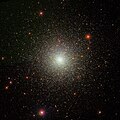 | |
| M4 | NGC 6121 | KuSH | 6.800 | Skorpion | 5,6 |  | |
| M5 | NGC 5904 | KuSH | 22.800 | Schlange | 5,6 |  | |
| M6 | NGC 6405 | Schmetterlingshaufen | OfSH | 2.000 | Skorpion | 5,3 | 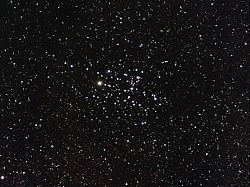 |
| M7 | NGC 6475 | Ptolemäus’ Sternhaufen | OfSH | 800 | Skorpion | 4,1 |  |
| M8 | NGC 6523 | Lagunennebel | DiNb | 5.200 | Schütze | 6,0 |  |
| M9 | NGC 6333 | KuSH | 26.400 | Schlangenträger | 7,7 |  | |
| M10 | NGC 6254 | KuSH | 13.400 | Schlangenträger | 6,7 |  | |
| M11 | NGC 6705 | Wildentenhaufen | OfSH | 6.000 | Schild | 6,3 | 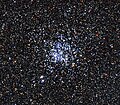 |
| M12 | NGC 6218 | KuSH | 17.600 | Schlangenträger | 6,6 |  | |
| M13 | NGC 6205 | Herkuleshaufen | KuSH | 22.200 | Herkules | 5,7 | 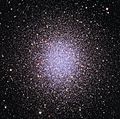 |
| M14 | NGC 6402 | KuSH | 27.400 | Schlangen- träger | 7,7 |  | |
| M15 | NGC 7078 | KuSH | 32.600 | Pegasus | 6,0 |  | |
| M16 | NGC 6611 | Adlernebel | OfSH+ DiNb | 7.000 | Schlange | 6,4 |  |
| M17 | NGC 6618 | Omeganebel | DiNb | 5.000 | Schütze | 7,5 |  |
| M18 | NGC 6613 | OfSH | 4.900 | Schütze | 7,5 |  | |
| M19 | NGC 6273 | KuSH | 27.100 | Schlangenträger | 6,6 | 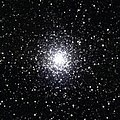 | |
| M20 | NGC 6514 | Trifid- Nebel | DiNb | 5.200 | Schütze | 9,0 |  |
| M21 | NGC 6531 | OfSH | 4.250 | Schütze | 6,5 |  | |
| M22 | NGC 6656 | KuSH | 10.100 | Schütze | 5,9 |  | |
| M23 | NGC 6494 | OfSH | 2.150 | Schütze | 6,9 |  | |
| M24 | IC 4715 | Sagittariuswolke/ Delle Caustiche | Ast. | 10.000 | Schütze | 4,6 |  |
| M25 | IC 4725 | OfSH | 2.000 | Schütze | 6,5 | 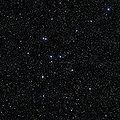 | |
| M26 | NGC 6694 | OfSH | 5.000 | Schild | 9,3 |  | |
| M27 | NGC 6853 | Hantelnebel | PlNb | 1.250 | Fuchs | 7,4 |  |
| M28 | NGC 6626 | KuSH | 15.000 | Schütze | 7,3 |  | |
| M29 | NGC 6913 | OfSH | 7.200 | Schwan | 7,1 |  | |
| M30 | NGC 7099 | KuSH | 25.000 | Steinbock | 8,4 | (c) ESA/Hubble, CC BY 4.0 | |
| M31 | NGC 224 | Andromedagalaxie | SpiG (Sb) | 2.900.000 | Andromeda | 3,4 | 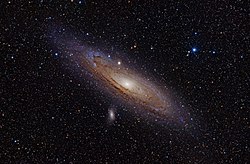 |
| M32 | NGC 221 | ZwG | 2.900.000 | Andromeda | 8,1 |  | |
| M33 | NGC 598 | Dreiecksnebel | SpiG (Sc) | 3.000.000 | Dreieck | 5,7 |  |
| M34 | NGC 1039 | OfSH | 1.400 | Perseus | 5,5 |  | |
| M35 | NGC 2168 | OfSH | 2.800 | Zwillinge | 5,3 |  | |
| M36 | NGC 1960 | OfSH | 4.100 | Fuhrmann | 6,3 | 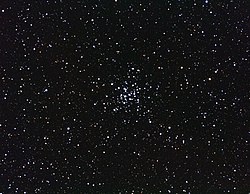 | |
| M37 | NGC 2099 | OfSH | 4.400 | Fuhrmann | 6,2 | 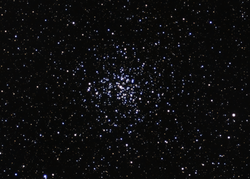 | |
| M38 | NGC 1912 | OfSH | 4.200 | Fuhrmann | 7,4 |  | |
| M39 | NGC 7092 | OfSH | 825 | Schwan | 4,6 |  | |
| M40 | keine | Winnecke 4 | DS (Ast.) | 510 | Großer Bär | 8,4 |  |
| M41 | NGC 2287 | OfSH | 2.300 | Großer Hund | 4,5 |  | |
| M42 | NGC 1976 | Orionnebel | DiNb | 1.300 | Orion | 4,0 |  |
| M43 | NGC 1982 | de Mairans- Nebel in der Abbildung oben links zu sehen; gilt heute als Teil des Orionnebels M42 | DiNb | 1.300 | Orion | 9,0 |  |
| M44 | NGC 2632 | Krippe (Praesepe) | OfSH | 577 | Krebs | 3,7 | 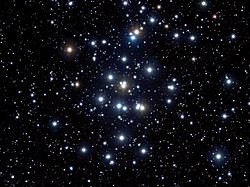 |
| M45 | NGC 1435 | Plejaden | OfSH | 440 | Stier | 1,6 | 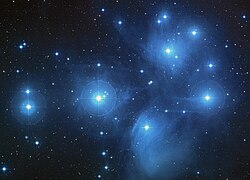 |
| M46 | NGC 2437 | OfSH | 5.400 | Achterdeck des Schiffs | 6,0 |  | |
| M47 | NGC 2422 | OfSH | 1.600 | Achterdeck des Schiffs | 4,5 | 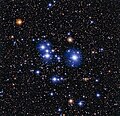 | |
| M48 | NGC 2548 | OfSH | 1.500 | Wasserschlange | 5,5 |  | |
| M49 | NGC 4472 | EllG | 60.000.000 | Jungfrau | 8,4 |  | |
| M50 | NGC 2323 | OfSH | 3.200 | Einhorn | 5,9 |  | |
| M51 | NGC 5194+ NGC 5195 | Whirlpool- Galaxie | SpiG (Sc1) | 37.000.000 | Jagdhunde | M51: 8,4 M51b: 9,6 | 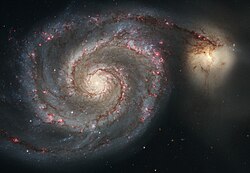 |
| M52 | NGC 7654 | OfSH | 5.000 | Kassiopeia | 7,3 | 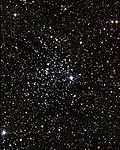 | |
| M53 | NGC 5024 | KuSH | 58.000 | Haar der Berenike | 7,6 | 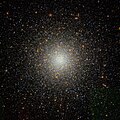 | |
| M54 | NGC 6715 | KuSH | 87.400 | Schütze | 7,6 |  | |
| M55 | NGC 6809 | KuSH | 17.300 | Schütze | 6,3 |  | |
| M56 | NGC 6779 | KuSH | 32.900 | Leier | 8,3 |  | |
| M57 | NGC 6720 | Ring- Nebel | PlNb | 4.100 | Leier | 8,8 |  |
| M58 | NGC 4579 | BaSpiG (Sb/SBb) | 60.000.000 | Jungfrau | 9,7 |  | |
| M59 | NGC 4621 | EllG | 60.000.000 | Jungfrau | 9,6 | (c) ESA/Hubble, CC BY 4.0 | |
| M60 | NGC 4649 | EllG | 60.000.000 | Jungfrau | 8,8 |  | |
| M61 | NGC 4303 | SpiG (Sc) | 60.000.000 | Jungfrau | 9,7 |  | |
| M62 | NGC 6266 | KuSH | 22.500 | Schlangen- träger | 6,5 |  | |
| M63 | NGC 5055 | Sonnenblumengalaxie | SpiG (Sb) | 37.000.000 | Jagdhunde | 8,6 |  |
| M64 | NGC 4826 | Black-Eye- Galaxie | SpiG (Sb) | 12.000.000 | Haar der Berenike | 8,5 |  |
| M65 | NGC 3623 | SpiG | 35.000.000 | Löwe | 9,3 | 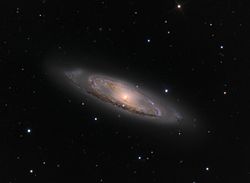 | |
| M66 | NGC 3627 | BaSpiG | 35.000.000 | Löwe | 8,9 |  | |
| M67 | NGC 2682 | OfSH | 2.700 | Krebs | 6,1 | 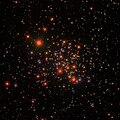 | |
| M68 | NGC 4590 | KuSH | 33.300 | Wasserschlange | 7,8 |  | |
| M69 | NGC 6637 | KuSH | 29.700 | Schütze | 7,6 |  | |
| M70 | NGC 6681 | KuSH | 29.300 | Schütze | 7,9 | (c) ESA/Hubble & NASA, CC BY 4.0 | |
| M71 | NGC 6838 | KuSH | 13.000 | Pfeil | 8,2 |  | |
| M72 | NGC 6981 | KuSH | 55.400 | Wassermann | 9,3 |  | |
| M73 | NGC 6994 | Ast. | 2.500 | Wassermann | 9,0 |  | |
| M74 | NGC 628 | SpiG | 35.000.000 | Fische | 9,4 | 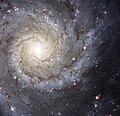 | |
| M75 | NGC 6864 | KuSH | 67.500 | Schütze | 8,5 |  | |
| M76 | NGC 650+ NGC 651 | Kleiner Hantelnebel | PlNb | 3.400 | Perseus | 10,1 | 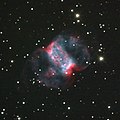 |
| M77 | NGC 1068 | SpiG | 60.000.000 | Walfisch | 8,9 | 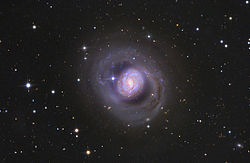 | |
| M78 | NGC 2068 | ReNb | 1.600 | Orion | 8,3 |  | |
| M79 | NGC 1904 | KuSH | 42.100 | Hase | 7,7 |  | |
| M80 | NGC 6093 | KuSH | 32.600 | Skorpion | 7,3 |  | |
| M81 | NGC 3031 | Bode- Nebel | SpiG (Sb) | 12.000.000 | Großer Bär | 6,9 | 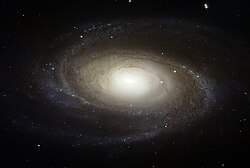 |
| M82 | NGC 3034 | Zigarren- Galaxie | SpiG (SBc) | 11.000.000 | Großer Bär | 8,4 | 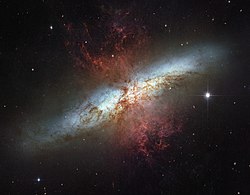 |
| M83 | NGC 5236 | südl. Feuerrad- Galaxie | SpiG | 15.000.000 | Wasserschlange | 7,6 | 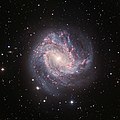 |
| M84 | NGC 4374 | EllG (E0) | 60.000.000 | Jungfrau | 9,1 |  | |
| M85 | NGC 4382 | EllG (E0) | 60.000.000 | Haar der Berenike | 9,1 |  | |
| M86 | NGC 4406 | EllG (E0) | 60.000.000 | Jungfrau | 8,9 | 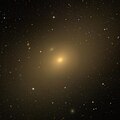 | |
| M87 | NGC 4486 | Virgo A- Galaxie | EllG | 60.000.000 | Jungfrau | 8,6 |  |
| M88 | NGC 4501 | SpiG | 60.000.000 | Haar der Berenike | 9,6 |  | |
| M89 | NGC 4552 | EllG | 60.000.000 | Jungfrau | 9,8 |  | |
| M90 | NGC 4569 | SpiG | 60.000.000 | Jungfrau | 9,5 |  | |
| M91 | NGC 4548 | SpiG | 60.000.000 | Haar der Berenike | 10,2 | 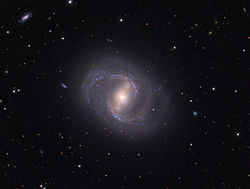 | |
| M92 | NGC 6341 | KuSH | 26.700 | Herkules | 6,4 |  | |
| M93 | NGC 2447 | OfSH | 3.600 | Achterdeck des Schiffs | 6,0 |  | |
| M94 | NGC 4736 | SpiG | 14.500.000 | Jagdhunde | 8,2 |  | |
| M95 | NGC 3351 | SpiG | 38.000.000 | Löwe | 9,7 |  | |
| M96 | NGC 3368 | SpiG | 38.000.000 | Löwe | 9,2 |  | |
| M97 | NGC 3587 | Eulennebel | PlNb | 2.600 | Großer Bär | 9,9 |  |
| M98 | NGC 4192 | SpiG | 60.000.000 | Haar der Berenike | 10,1 | 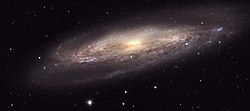 | |
| M99 | NGC 4254 | SpiG | 60.000.000 | Haar der Berenike | 9,9 |  | |
| M100 | NGC 4321 | SpiG | 60.000.000 | Haar der Berenike | 9,3 |  | |
| M101 | NGC 5457 | Feuerrad- Galaxie | SpiG | 27.000.000 | Großer Bär | 7,9 | (c) ESA/Hubble, CC BY 4.0 |
| M102 | NGC 5866 | EllG (E0) | 45.000.000 | Drache | 9,9 |  | |
| M103 | NGC 581 | OfSH | 8.500 | Kassiopeia | 7,4 |  | |
| M104 | NGC 4594 | Sombrerogalaxie | SpiG (Sa) | 50.000.000 | Jungfrau | 8,0 | 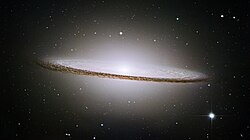 |
| M105 | NGC 3379 | EllG | 38.000.000 | Löwe | 9,3 | 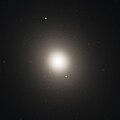 | |
| M106 | NGC 4258 | SpiG | 25.000.000 | Jagdhunde | 8,4 |  | |
| M107 | NGC 6171 | KuSH | 20.900 | Schlangen- träger | 7,9 |  | |
| M108 | NGC 3556 | SpiG | 45.000.000 | Großer Bär | 10,0 |  | |
| M109 | NGC 3992 | SpiG | 55.000.000 | Großer Bär | 9,8 | 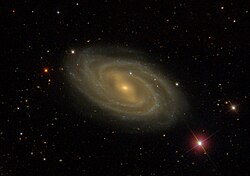 | |
| M110 | NGC 205 | EllG | 2.900.000 | Andromeda | 8,5 |  |
Siehe auch
Literatur
- Ronald Stoyan, Stefan Binnewies, Susanne Friedrich, Klaus-Peter Schroeder: Atlas of the Messier Objects. Cambridge University Press 2008, ISBN 978-0-521-89554-5.
- Ronald Stoyan: Messier Guide. Oculum-Verlag, Erlangen 2020, ISBN 978-3-938469-94-1.
- Stephen James O’Meara: The Messier Objects. Second Edition, Cambridge University Press 2014, ISBN 978-1-107-01837-2.
Weblinks
- Charles Messiers Originalkatalog
- Videos zu allen Messier-Objekten bei deepskyvideos.
- Messier Catalog Website (SEDS)
- Messier im Fernglas bei freunde-der-nacht.net
- Drawings of Messier Deep Sky Objects bei deepskywatch.com
Einzelnachweise
- ↑ Michael Odenkirchen, Caroline Soubiran: NGC 6994 – clearly not a physical stellar ensemble. In: Astronomy and Astrophysics. Bd. 383, Nr. 1, 2002, S. 163–170, doi:10.1051/0004-6361:20011730.
- ↑ Daniela B. Pavani, Eduardo Bica: Characterization of open cluster remnants. In: Astronomy and Astrophysics. Bd. 468, Nr. 1, 2007, S. 139–150, doi:10.1051/0004-6361:20066240.
- ↑ a b die Messierobjekte auf SEDS
Auf dieser Seite verwendete Medien
Bildtafel der 110 Messier-Objekte. Diese Datei wird in der w:de:Template:Navigationsleiste Messierobjekte als Imagemap genutzt. Sie darf daher nicht durch eine andere Version überschrieben werden!
Autor/Urheber: NASA, ESA, S. Beckwith (STScI), and The Hubble Heritage Team STScI/AURA), Lizenz: CC BY 3.0
The Whirlpool Galaxy (Spiral Galaxy M51, NGC 5194) is a classic spiral galaxy located in the Canes Venatici constellation.
Out of this whirl: The Whirlpool Galaxy (M51) and companion galaxy
The graceful, winding arms of the majestic spiral galaxy M51 (NGC 5194) appear like a grand spiral staircase sweeping through space. They are actually long lanes of stars and gas laced with dust.
This sharpest-ever image, taken in January 2005 with the Advanced Camera for Surveys aboard the NASA/ESA Hubble Space Telescope, illustrates a spiral galaxy's grand design, from its curving spiral arms, where young stars reside, to its yellowish central core, a home of older stars. The galaxy is nicknamed the Whirlpool because of its swirling structure.
The Whirlpool's most striking feature is its two curving arms, a hallmark of so-called grand-design spiral galaxies. Many spiral galaxies possess numerous, loosely shaped arms that make their spiral structure less pronounced. These arms serve an important purpose in spiral galaxies. They are star-formation factories, compressing hydrogen gas and creating clusters of new stars. In the Whirlpool, the assembly line begins with the dark clouds of gas on the inner edge, then moves to bright pink star-forming regions, and ends with the brilliant blue star clusters along the outer edge.
Some astronomers believe that the Whirlpool's arms are so prominent because of the effects of a close encounter with NGC 5195, the small, yellowish galaxy at the outermost tip of one of the Whirlpool's arms. At first glance, the compact galaxy appears to be tugging on the arm. Hubble's clear view, however, shows that NGC 5195 is passing behind the Whirlpool. The small galaxy has been gliding past the Whirlpool for hundreds of millions of years.
As NGC 5195 drifts by, its gravitational muscle pumps up waves within the Whirlpool's pancake-shaped disk. The waves are like ripples in a pond generated when a rock is thrown in the water. When the waves pass through orbiting gas clouds within the disk, they squeeze the gaseous material along each arm's inner edge. The dark dusty material looks like gathering storm clouds. These dense clouds collapse, creating a wake of star birth, as seen in the bright pink star-forming regions. The largest stars eventually sweep away the dusty cocoons with a torrent of radiation, hurricane-like stellar winds, and shock waves from supernova blasts. Bright blue star clusters emerge from the mayhem, illuminating the Whirlpool's arms like city streetlights.
The Whirlpool is one of astronomy's galactic darlings. Located 31 million light-years away in the constellation Canes Venatici (the Hunting Dogs), the Whirlpool's beautiful face-on view and closeness to Earth allow astronomers to study a classic spiral galaxy's structure and star-forming processes.
Credit:
NASA, ESA, S. Beckwith (STScI), and The Hubble Heritage Team STScI/AURA)
About the Image
NASA caption Id: heic0506a Type: Observation Release date: 25 April 2005, 06:00 Related releases: heic0506 Size: 11477 x 7965 px
About the Object
Name: Messier 51, Whirlpool Galaxy Type: • Local Universe : Galaxy : Type : Spiral • Galaxies Images/Videos Distance: 25 million light years
Colours & filters
Band Wavelength Telescope Optical B 435 nm Hubble Space Telescope ACS Optical V 555 nm Hubble Space Telescope ACS Optical H-alpha + Nii 658 nm Hubble Space Telescope ACS Infrared I 814 nm Hubble Space Telescope ACS.
This is a mosaic image, one of the largest ever taken by NASA's Hubble Space Telescope, of the Crab Nebula, a six-light-year-wide expanding remnant of a star's supernova explosion. Japanese and Chinese astronomers recorded this violent event in 1054 CE.
The orange filaments are the tattered remains of the star and consist mostly of hydrogen. The rapidly spinning neutron star embedded in the center of the nebula is the dynamo powering the nebula's eerie interior bluish glow. The blue light comes from electrons whirling at nearly the speed of light around magnetic field lines from the neutron star. The neutron star, like a lighthouse, ejects twin beams of radiation that appear to pulse 30 times a second due to the neutron star's rotation. A neutron star is the crushed ultra-dense core of the exploded star.
The Crab Nebula derived its name from its appearance in a drawing made by Irish astronomer Lord Rosse in 1844, using a 36-inch telescope. When viewed by Hubble, as well as by large ground-based telescopes such as the European Southern Observatory's Very Large Telescope, the Crab Nebula takes on a more detailed appearance that yields clues into the spectacular demise of a star, 6,500 light-years away.
The newly composed image was assembled from 24 individual Wide Field and Planetary Camera 2 exposures taken in October 1999, January 2000, and December 2000. The colors in the image indicate the different elements that were expelled during the explosion. Blue in the filaments in the outer part of the nebula represents neutral oxygen, green is singly-ionized sulfur, and red indicates doubly-ionized oxygen.Autor/Urheber: HST / Fabian RRRR (talk), Lizenz: CC BY-SA 3.0
Color rendering is done by by Aladin-software (2000A&AS..143...33B.)
Autor/Urheber: Sloan Digital Sky Survey, Lizenz: CC BY 4.0

Angle of view: 12' x 12' (0.3515625" per pixel), north is up.
Details on the image processing pipeline: https://www.sdss.org/dr14/imaging/jpg-images-on-skyserver/Autor/Urheber:
KPNO/NOIRLab/NSF/AURA Acknowledgment: PI: M.T. Patterson (New Mexico State University)
Image processing: T.A. Rector (University of Alaska Anchorage), M. Zamani & D. de Martin, Lizenz: CC BY 4.0This image of the spiral galaxy Messier 106, or NGC 4258, was taken with the Nicholas U. Mayall 4-meter Telescope at Kitt Peak National Observatory, a Program of NSF’s NOIRLab. A popular target for amateur astronomers, Messier 106 can also be spotted with a small telescope in the constellation Canes Venatici. This view captures the entire galaxy, detailing the glowing spiral arms, wisps of gas, and dust lanes at the center of Messier 106 as well as the leisurely twisting bands of stars at the galaxy’s outer edges. Two dwarf galaxies also appear in the image: NGC 4248 in the lower right and UGC 7358 in the lower left.
Autor/Urheber: NiKo, Lizenz: CC BY 4.0
NGC 2168 (Messier 35); aufgenommen 2024 in Krefeld, Deutschland mit einem Skywatcher Equinox 80/500; ZWO ASI 183MC Pro Color; Gesamtbelichtungszeit von 1h; Bild ist beschnitten
Autor/Urheber: ESO/Igor Chekalin, Lizenz: CC BY 4.0
Dieses Bild des Reflexionsnebels Messier 78 wurde mit dem 2,2-Meter-MPG/ESO-Teleskop am La-Silla-Observatorium in Chile aufgenommen. Dieses Farbbild wurde aus vielen monochromen Belichtungen erstellt, die durch Blau-, Gelb-/Grün- und Rotfilter aufgenommen wurden, ergänzt durch Belichtungen durch einen Filter, der Licht von glühendem Wasserstoffgas isoliert. Die Gesamtbelichtungszeiten betrugen 9, 9, 17,5 bzw. 15,5 Minuten pro Filter.
Autor/Urheber: R Jay Gabany (Blackbird Obs.), Lizenz: CC BY-SA 3.0
Beautiful spiral galaxy M94 (Messier 94) lies a mere 15 million light-years distant in the northern constellation of the hunting dogs, Canes Venatici. A popular target for astronomers, the brighter inner part of the face-on galaxy is about 30,000 light-years across. Traditionally, deep images have been interpreted as showing M94's inner spiral region surrounded by a faint, broad ring of stars. But a new multi-wavelength investigation has revealed previously undetected spiral arms sweeping across the outskirts of the galaxy's disk, an outer disk actively engaged in star formation. At optical wavelengths, M94's outer spiral arms are followed in this remarkable discovery image, processed to enhance the outer disk structure. Background galaxies are visible through the faint outer arms, while the three spiky foreground stars are in our own Milky Way galaxy.
Autor/Urheber: Sloan Digital Sky Survey, Lizenz: CC BY 4.0

Angle of view: 7.5' x 7.5' (0.3515625" per pixel), north is up.
Details on the image processing pipeline: https://www.sdss.org/dr14/imaging/jpg-images-on-skyserver/Autor/Urheber: ESO/S. Guisard, Lizenz: CC BY 4.0
An amazing vista of the Lagoon Nebula taken with the 67-million-pixel Wide Field Imager attached to the MPG/ESO 2.2-metre telescope at the La Silla Observatory in Chile. The image covers more than one and a half square degree— an area eight times larger than that of the Full Moon — with a total of about 370 million pixels. It is based on images acquired using three different broadband filters (B, V, R) and one narrow-band filter (H-alpha).
Autor/Urheber: Credit: Adam Block, Lizenz: CC BY-SA 3.0 us
M13
Picture Details:
Optics 32-inch Schulman RC Optical Systems Telescope Camera SBIG STX 16803 CCD Camera Filters AstroDon Gen II Dates May 2016 Location Mount Lemmon SkyCenter Exposure RGB = 5 : 5 : 5 Hours Acquisition Maxim DL/CCD (Cyanogen), AStronomer Control Panel (DC3- Dreams) Processing CCDStack (CCDWare), Photoshop CC, PixInsight Credit Line and Copyright Adam Block/Mount Lemmon SkyCenter/University of Arizona.
This image of Messier 64 (M64) was taken with Hubble's Wide Field Planetary Camera 2 (WFPC2). The color image is a composite prepared by the Hubble Heritage Team from pictures taken through four different color filters. These filters isolate blue and near-infrared light, along with red light emitted by hydrogen atoms and green light from Strömgren y.
M64 has a spectacular dark band of absorbing dust in front of the galaxy's bright nucleus, giving rise to its nicknames of the Black Eye or Evil Eye galaxy.
At first glance, M64 appears to be a fairly normal pinwheel-shaped spiral galaxy. As in the majority of galaxies, all of the stars in M64 are rotating in the same direction, clockwise as seen in the Hubble image. However, detailed studies in the 1990's led to the remarkable discovery that the interstellar gas in the outer regions of M64 rotates in the opposite direction from the gas and stars in the inner regions.
Active formation of new stars is occurring in the shear region where the oppositely rotating gases collide, are compressed, and contract. Particularly noticeable in the image are hot, blue young stars that have just formed, along with pink clouds of glowing hydrogen gas that fluoresce when exposed to ultraviolet light from newly formed stars.
Astronomers believe that the oppositely rotating gas arose when M64 absorbed a satellite galaxy that collided with it, perhaps more than one billion years ago. This small galaxy has now been almost completely destroyed, but signs of the collision persist in the backward motion of gas at the outer edge of M64.Autor/Urheber: ESA/Hubble & NASA, Lizenz: CC BY 3.0
The object shown in this beautiful Hubble image, dubbed Messier 54, could be just another globular cluster, but this dense and faint group of stars was in fact the first globular cluster found that is outside our galaxy. Discovered by the famous astronomer Charles Messier in 1778, Messier 54 belongs to a satellite of the Milky Way called the Sagittarius Dwarf Elliptical Galaxy.
Messier had no idea of the significance of his discovery at the time, and it wasn’t until over two centuries later, in 1994, that astronomers found Messier 54 to be part of the miniature galaxy and not our own. Current estimates indicate that the Sagittarius dwarf, and hence the cluster, is situated almost 90 000 light-years away — more than three times as far from the centre of our galaxy than the Solar System.
Ironically, even though this globular cluster is now understood to lie outside the Milky Way, it will actually become part of it in the future. The strong gravitational pull of our galaxy is slowly engulfing the Sagittarius dwarf, which will eventually merge with the Milky Way creating one much larger galaxy.
This picture is a composite created by combining images taken with the Wide Field Channel of Hubble’s Advanced Camera for Surveys. Light that passed through a yellow-orange (F606W) was coloured blue and light passing through a near-infrared filter (F814W) was coloured red. The total exposure times were 3460 s and 3560 s, respectively and the field of view is approximately 3.4 by 3.4 arcminutes.Autor/Urheber: ESO, Lizenz: CC BY 4.0
The star cluster Messier 47 This spectacular image of the star cluster Messier 47 was taken using the Wide Field Imager camera, installed on the MPG/ESO 2.2-metre telescope at ESO’s La Silla Observatory in Chile. This young open cluster is dominated by a sprinkling of brilliant blue stars but also contains a few contrasting red giant stars.
Autor/Urheber: Till Credner und Sven Kohle, Calar Alto Observatory, Lizenz: CC BY-SA 2.0 de
Kugelsternhaufen M 71
Photograph from the Two Micron All-Sky Survey (2MASS) of Messier 34 (also known as M 34 or NGC 1039), an open cluster in the constellation Perseus.
Autor/Urheber: Sloan Digital Sky Survey, Lizenz: CC BY 4.0

Angle of view: 12' x 12' (0.3515625" per pixel), north is up.
Details on the image processing pipeline: https://www.sdss.org/dr14/imaging/jpg-images-on-skyserver/Autor/Urheber: Adam Evans, Lizenz: CC BY 2.0
Die Andromedagalaxie ist eine Spiralgalaxie im Sternbild Andromeda (etwa 2,4 bis 2,9 Millionen Lichtjahre entfernt). Das Foto zeigt auch die Messierobjekte 32 und 110 sowie NGC 206 (eine helle Sternassoziation in der Andromedagalaxie) und den Stern ν Andromedae. Kombination von LRGB- und Hα-Bilddaten.
From original NASA press release:
- This is a unique view of the disk galaxy NGC 5866 tilted nearly edge-on to our line-of-sight. Hubble's sharp vision reveals a crisp dust lane dividing the galaxy into two halves. The image highlights the galaxy's structure: a subtle, reddish bulge surrounding a bright nucleus, a blue disk of stars running parallel to the dust lane, and a transparent outer halo. NGC 5866 is a disk galaxy of type "S0" (pronounced s-zero). Viewed face on, it would look like a smooth, flat disk with little spiral structure. It remains in the spiral category because of the flatness of the main disk of stars as opposed to the more spherically rotund (or ellipsoidal) class of galaxies called ellipticals. Such S0 galaxies, with disks like spirals and large bulges like ellipticals, are called lenticular galaxies. NGC 5866 lies in the Northern constellation Draco, at a distance of 44 million light-years. It has a diameter of roughly 60,000 light-years only two-thirds the diameter of the Milky Way, although its mass is similar to our galaxy. This Hubble image of NGC 5866 is a combination of blue, green and red observations taken with the Advanced Camera for Surveys in February 2006.
And from the image's page:
- This is a unique NASA Hubble Space Telescope view of the disk galaxy NGC 5866 tilted nearly edge-on to our line-of-sight.
- Hubble's sharp vision reveals a crisp dust lane dividing the galaxy into two halves. The image highlights the galaxy's structure: a subtle, reddish bulge surrounding a bright nucleus, a blue disk of stars running parallel to the dust lane, and a transparent outer halo.
- Some faint, wispy trails of dust can be seen meandering away from the disk of the galaxy out into the bulge and inner halo of the galaxy. The outer halo is dotted with numerous gravitationally bound clusters of nearly a million stars each, known as globular clusters. Background galaxies that are millions to billions of light-years farther away than NGC 5866 are also seen through the halo.
- NGC 5866 is a disk galaxy of type "S0" (pronounced s-zero). Viewed face on, it would look like a smooth, flat disk with little spiral structure. It remains in the spiral category because of the flatness of the main disk of stars as opposed to the more spherically rotund (or ellipsoidal) class of galaxies called "ellipticals." Such S0 galaxies, with disks like spirals and large bulges like ellipticals, are called 'lenticular' galaxies.
- The dust lane is slightly warped compared to the disk of starlight. This warp indicates that NGC 5866 may have undergone a gravitational tidal disturbance in the distant past, by a close encounter with another galaxy. This is plausible because it is the largest member of a small cluster known as the NGC 5866 group of galaxies. The starlight disk in NGC 5866 extends well beyond the dust disk. This means that dust and gas still in the galaxy and potentially available to form stars does not stretch nearly as far out in the disk as it did when most of these stars in the disk were formed.
- The Hubble image shows that NGC 5866 shares another property with the more gas-rich spiral galaxies. Numerous filaments that reach out perpendicular to the disk punctuate the edges of the dust lane. These are short-lived on an astronomical scale, since clouds of dust and gas will lose energy to collisions among themselves and collapse to a thin, flat disk.
- For spiral galaxies, the incidence of these fingers of dust correlates well with indicators of how many stars have been formed recently, as the input of energy from young massive stars moves gas and dust around to create these structures. The thinness of dust lanes in S0s has been discussed in ground-based galaxy atlases, but it took the resolution of Hubble to show that they can have their own smaller fingers and chimneys of dust.
- NGC 5866 lies in the Northern constellation Draco, at a distance of 44 million light-years (13.5 Megaparsecs). It has a diameter of roughly 60,000 light-years (18,400 parsecs) only two-thirds the diameter of the Milky Way, although its mass is similar to our galaxy. This Hubble image of NGC 5866 is a combination of blue, green and red observations taken with the Advanced Camera for Surveys in November 2005.
Autor/Urheber: Ngc1535, Lizenz: CC BY-SA 4.0
Deep exposures of Galaxies
using the 0.8m Schulman Telescope at the Mount Lemmon SkyCenter
Credit Line & Copyright Adam Block/Mount Lemmon SkyCenter/University of ArizonaAutor/Urheber: Credit Line and Copyright Adam Block/Mount Lemmon SkyCenter/University of Arizona, Lizenz: CC BY-SA 3.0 us
Picture Details:
Optics 32-inch Schulman Telescope (RC Optical Systems), Acquired remotely Camera SBIG STX 16803 CCD Camera Filters AstroDon Gen II Dates January 2012 Location Mount Lemmon SkyCenter Exposure LRGB = 240:70:70:70 minutes Acquisition ACP Observatory Control Software (DC-3 Dreams),TheSky (Software Bisque), Maxim DL/CCD (Cyanogen) Processing CCDStack (CCDWare), Photoshop CS5 (Adobe), PixInsightCredit Line and Copyright Adam Block/Mount Lemmon SkyCenter/University of Arizona
Messier 22, Globular Cluster
Messier 105
M105 (aka NGC 3379) - Hubble peered into the core of M105 (also known as NGC 3379) and measured the motions of stars swirling around its center. These observations proved that a supermassive black hole resides at the galaxy’s heart. According to recent estimates, this black hole could be up to 200 million times as massive as our Sun. Credits: NASA, ESA, Karl Gebhardt (University of Michigan) and Tod Lauer (NOAO)
M105 is an elliptical galaxy 32 billion light-years away in the constellation Leo. It is the largest elliptical in the Messier catalog that is not a member of the Virgo cluster of galaxies. M105 does, however, belong to the M96 (or Leo I) Group, which includes neighbors M95 and M96 as well as several other fainter galaxies. Charles Messier’s colleague Pierre Méchain discovered M105 in 1781 just a few days after locating M95 and M96. Yet M105 was not originally included in Messier’s catalog. It was added in 1947 after astronomer Helen S. Hogg found a letter written by Méchain describing the galaxy.
This Hubble image of M105 was taken in near-infrared and visible light. Like most elliptical galaxies it appears rather featureless and inactive. However, Hubble observations surprised astronomers by revealing young stars and star clusters in M105, indicating that star formation is still taking place in what was thought to be a “dead” galaxy no longer capable of giving birth to new stars. Other Hubble observations measured the speeds of stars moving around the center of the galaxy, which demonstrated that a supermassive black hole resides at M105’s core.
Best observed in April, M105 has an apparent magnitude of 10.2 and can be spotted with a small telescope. Large telescopes will uncover two fainter galaxies (NGC 3384 and NGC 3389) close to the bright elliptical.
For more information about Hubble’s observations of M105, see:
http://hubblesite.org/news_release/news/1997-01The planetary nebula Messier 57, also known as the Ring Nebula, in the constellation Lyra (NGC 6720, GC 4447).
Autor/Urheber: HST / Fabian RRRR (talk), Lizenz: CC BY-SA 3.0
Color rendering is done by by Aladin-software (2000A&AS..143...33B.)
Autor/Urheber: Sloan Digital Sky Survey, Lizenz: CC BY 4.0

Angle of view: 12' x 12' (0.3515625" per pixel), north is up.
Details on the image processing pipeline: https://www.sdss.org/dr14/imaging/jpg-images-on-skyserver/Autor/Urheber: ESO, Lizenz: CC BY 4.0
Three-colour composite mosaic image of the Eagle Nebula (Messier 16, or NGC 6611), based on images obtained with the Wide-Field Imager camera on the MPG/ESO 2.2-metre telescope at the La Silla Observatory. At the centre, the so-called “Pillars of Creation” can be seen. This wide-field image shows not only the central pillars, but also several others in the same star-forming region, as well as a huge number of stars in front of, in, or behind the Eagle Nebula. The cluster of bright stars to the upper right is NGC 6611, home to the massive and hot stars that illuminate the pillars. The “Spire” — another large pillar — is in the middle left of the image. This image is a composite of 3 filters in the visible range: B (blue), V (green) and R (red).
(c) ESA/Hubble, CC BY 4.0
This brilliant image of Messier 30 (M 30) was taken by Hubble's Advanced Camera for Surveys (ACS). Messier 30 formed 13 billion years ago and was discovered in 1764 by Charles Messier. Located about 28000 light-years away from Earth, this globular cluster — a dense swarm of several hundred thousand stars — is about 90 light-years across.
Although globular clusters such as this one are mainly populated by old stars, the crowded field of stars leads to some old stars apparently reclaiming their youth in the form of blue stragglers. Researchers using data from Hubble's now-retired Wide Field Planetary Camera 2 (WFPC2) have identified two types of blue stragglers in Messier 30: those that form in near head-on collisions with one another and those that are in twin (or binary) systems where the less massive star siphons "life-giving" hydrogen from its more massive companion.Autor/Urheber: Der ursprünglich hochladende Benutzer war Clh288 in der Wikipedia auf Englisch, Lizenz: CC BY-SA 2.5
An image of M98. Credit: Astrofotografía http://astroguia.org/astroalbum/displayimage.php?pos=-309
en:Category:Galaxy images(c) ESA/Hubble, CC BY 4.0
Bucking the trend
This luminous orb is the galaxy NGC 4621, better known as Messier 59. As this latter moniker indicates, the galaxy was listed in the famous catalogue of deep-sky objects compiled by French comet-hunter Charles Messier in 1779. However, German astronomer Johann Gottfried Koehler is credited with discovering the galaxy just days before Messier added it to his collection.
Modern observations show that Messier 59 is an elliptical galaxy, one of the three main kinds of galaxies along with spirals and irregulars. Ellipticals tend to be the most evolved of the trio, full of old, red stars and exhibiting little or no new star formation. Messier 59, however, bucks this trend somewhat; the galaxy does show signs of star formation, with some newborn stars residing within a disc near the core.
Located in the 2000-strong Virgo Cluster of galaxies within the constellation of Virgo (The Virgin), Messier 59 lies approximately 50 million light-years away from us. This image was taken by the NASA/ESA Hubble Space Telescope’s Advanced Camera for Surveys.
Credit:
ESA/Hubble & NASA, P. Cote
Coordinates Position (RA): 12 42 2.17 Position (Dec): 11° 38' 47.46" Field of view: 3.13 x 2.50 arcminutes Orientation: North is 105.8° right of vertical
Colours & filters Band Wavelength Telescope Optical g 475 nm Hubble Space Telescope ACS Optical V 555 nm Hubble Space Telescope ACS Optical i 702 nm Hubble Space Telescope WFPC2 Optical z 850 nm Hubble Space Telescope ACS Optical i 702 nm Hubble Space Telescope WFPC2 Optical z 850 nm Hubble Space Telescope ACS.
Autor/Urheber: Sloan Digital Sky Survey, Lizenz: CC BY 4.0

Angle of view: 12' x 12' (0.3515625" per pixel), north is up.
Details on the image processing pipeline: https://www.sdss.org/dr14/imaging/jpg-images-on-skyserver/Autor/Urheber: Credit Line and Copyright Adam Block/Mount Lemmon SkyCenter/University of Arizona, Lizenz: CC BY-SA 3.0 us
M77
Picture Details:
Optics 24-inch RC Optical Systems Telescope Camera SBIG STL11000 CCD Camera Filters Custom Scientific Dates October 25th- October 26th 2008 Location Mount Lemmon SkyCenter Exposure LRGB = 290:60:60:60 minutes Acquisition TheSky (Software Bisque), Maxim DL/CCD (Cyanogen) Processing CCDStack (CCDWare), Mira (MiraMetrics), Maxim DL (Cyanogen), Photoshop CS3 (Adobe) Visiting Astronomers: Jimmy and Cathy DeanCredit Line and Copyright Adam Block/Mount Lemmon SkyCenter/University of Arizona
Autor/Urheber: Till Credner und Sven Kohle, Observatorium Hoher List, Lizenz: CC BY-SA 2.0 de
Kugelsternhaufen M 10
Autor/Urheber: ESO/Oleg Maliy, Lizenz: CC BY 3.0
Not all spiral galaxies have to be picture-perfect to be striking. Messier 96, also known as NGC 3368, is a case in point: its core is displaced from the centre, its gas and dust are distributed asymmetrically and its spiral arms are ill-defined. But this portrait, taken with the FORS1 instrument on ESO’s Very Large Telescope, shows that imperfection is beauty in Messier 96. The galaxy's core is compact but glowing, and the dark dust lanes around it move in a delicate swirl towards the nucleus. And the spiral arms, patchy rings of young blue stars, are like necklaces of blue pearls.
Messier 96 lies in the constellation of Leo (The Lion). It is the largest galaxy in the Leo I group of galaxies; including its outermost spiral arms, it spans some 100 000 light-years in diameter — about the size of our Milky Way. Its graceful imperfections likely result from the gravitational pull of other members in the group, or are perhaps due to past galactic encounters.
A multitude of background galaxies peers through the dusty spiral. Perhaps the most striking of these objects is an edge-on galaxy that — because of a chance alignment — appears to interrupt the outermost spiral arm to the upper left of Messier 96's core.
This image was processed by ESO using the observational data found by Oleg Maliy from Ukraine, who participated in ESO's Hidden Treasures 2010 astrophotography competition [1], organised in October–November 2010, for everyone who enjoys making beautiful images of the night sky using astronomical data obtained with professional telescopes. The image was made with data taken at visible and infrared wavelengths through B, V, and I filters.
Notes
[1] ESO’s Hidden Treasures 2010 competition gave amateur astronomers the opportunity to search through ESO’s vast archives of astronomical data, hoping to find a well-hidden gem that needed polishing by the entrants. To find out more about Hidden Treasures, visit http://www.eso.org/public/outreach/hiddentreasures/.Autor/Urheber:
Credit:
George Jacoby, WIYN/NSF, Lizenz: CC BY 4.0Emission line image of M27
This excellent image of the Dumbbell Nebula (M27, NGC6853), a planetary nebula in the constellation of Vulpecula, was taken at the 3.5-meter WIYN telescope using the mini-mosaic imager (described in an NOAO newsletter article). The nebula was formed when an evolved, red giant star ejected its outer envelope near the end of its lifetime. The expanding cloud of gas becomes visible once the hot core of the star, visible near the center, is exposed and the high-energy, ultraviolet light from the core ionizes the cloud. This makes the nebula emit mostly a strong emission-line spectrum. This color image was obtained by combining three separate pictures, each one taken through a narrow filter centered at the emission wavelengths of Hydrogen (H alpha, red, 656 nm), doubly ionized Oxygen (OIII, green, 501 nm), and neutral Oxygen (OI, blue, 630 nm). It is physically very interesting that neutral gas can survive in a region right next to highly ionized gas, and this image shows how, as the blue component is concentrated in very dense clumps which act to protect the neutral oxygen from the intense ultraviolet radiation which has ionized the other gas components. We can compare this to a picture combining three images all of ionized gases, (also from the WIYN telecope), and to the more usual color image from the Mayall 4-meter telescope, or the nice deep image from the 2.1-meter telescope. The Dumbbell nebula is about 850 light-years away from Earth and about 1.5 light-years in diameter (although both distance and size are very poorly constrained).
Credit:
George Jacoby, WIYN/NSF
Coordinates Position (RA): 19 59 36.22 Position (Dec): 22° 43' 14.39" Field of view: 8.70 x 8.70 arcminutes Orientation: North is 0.2° right of vertical
Colors & filters Band Wavelength Telescope Optical Ol 630 nm WIYN 3.5-meter Telescope Mini Mosaic Optical Olll 501 nm WIYN 3.5-meter Telescope Mini Mosaic Optical Ha 656 nm WIYN 3.5-meter Telescope Mini Mosaic.
Autor/Urheber: Sloan Digital Sky Survey, Lizenz: CC BY 4.0

Angle of view: 36' x 36' (0.52734375" per pixel), north is up.
Details on the image processing pipeline: https://www.sdss.org/dr14/imaging/jpg-images-on-skyserver/Autor/Urheber: European Southern Observatory, Lizenz: CC BY 4.0
Three-colour composite image of the Omega Nebula (Messier 17, or NGC 6618), based on images obtained with the EMMI instrument on the ESO 3.58-metre New Technology Telescope at the La Silla Observatory. North is down and East is to the right in the image. It spans an angle equal to about one third the diameter of the Full Moon, corresponding to about 15 light-years at the distance of the Omega Nebula. The three filters used are B (blue), V ("visual", or green) and R (red).
Autor/Urheber: ESO. Acknowledgement: ESO Imaging Survey, Lizenz: CC BY 3.0
This image from the Wide Field Imager attached to the MPG/ESO 2.2-metre telescope at ESO’s La Silla Observatory shows the spectacular globular star cluster Messier 4. This great ball of ancient stars is one of the closest of such stellar systems to the Earth and appears in the constellation of Scorpius (The Scorpion) close to the bright red star Antares.
Autor/Urheber: Sloan Digital Sky Survey, Lizenz: CC BY 4.0

Angle of view: 27' × 27' (0.792" per pixel), north is up.
Details on the image processing pipeline: https://www.sdss.org/dr14/imaging/jpg-images-on-skyserver/Autor/Urheber: Sloan Digital Sky Survey, Lizenz: CC BY 4.0

Angle of view: 24' x 24' (0.3515625" per pixel), north is up.
Details on the image processing pipeline: https://www.sdss.org/dr14/imaging/jpg-images-on-skyserver/The famous Sombrero galaxy (M104) is a bright nearby elliptical galaxy. The prominent dust lane and halo of stars and globular clusters give this galaxy its name. Something very energetic is going on in the Sombrero's center, as much X-ray light has been detected from it. This X-ray emission coupled with unusually high central stellar velocities cause many astronomers to speculate that a black hole lies at the Sombrero's center - a black hole a billion times the mass of our Sun.
The spiral galaxy Messier 81 is tilted at an oblique angle on to our line of sight, giving a "birds-eye view" of the spiral structure. The galaxy is similar to our Milky Way, but our favorable view provides a better picture of the typical architecture of spiral galaxies. Though the galaxy is 11.6 million light-years away, NASA Hubble Space Telescope's view is so sharp that it can resolve individual stars, along with open star clusters, globular star clusters, and even glowing regions of fluorescent gas.
Autor/Urheber: ESO, Lizenz: CC BY 3.0
The Very Large Telescope has captured another member of the Leo I group of galaxies, in the constellation of Leo (The Lion). The galaxy Messier 95 stands boldly face-on, offering an ideal view of its spiral structure. The spiral arms form an almost perfect circle around the galactic centre before they spread out, creating a mane-like effect of which any lion would be proud.
Another, perhaps even more striking, feature of Messier 95 is its blazing golden core. It contains a nuclear star-forming ring, almost 2000 light-years across, where a large proportion of the galaxy’s star formation takes place. This phenomenon occurs mostly in barred spiral galaxies such as Messier 95 and our home, the Milky Way.
In the Leo I group, Messier 95 is outshone by its brother Messier 96 (see potw1143). Messier 96 is in fact the brightest member of the group and — as “leader of the pride” — also gives Leo I its alternative name of the M 96 group. Nevertheless, Messier 95 also makes for a spectacular image.Autor/Urheber: HST / Fabian RRRR (talk), Lizenz: CC BY-SA 3.0
Color rendering is done by by Aladin-software (2000A&AS..143...33B.)
The grand-design spiral galaxy Messier 74 as photographed by the Hubble Space Telescope.
Autor/Urheber: Sloan Digital Sky Survey, Lizenz: CC BY 4.0

Angle of view: 12' x 12' (0.3515625" per pixel), north is up.
Details on the image processing pipeline: https://www.sdss.org/dr14/imaging/jpg-images-on-skyserver/The open cluster Messier 41
Messier object 9 - globular cluster in Ophiucus constellation by Hubble space telescope
Autor/Urheber: Sloan Digital Sky Survey, Lizenz: CC BY 4.0

Angle of view: 14' x 14' (0.42" per pixel), north is up.
Details on the image processing pipeline: https://www.sdss.org/dr14/imaging/jpg-images-on-skyserver/Messier 107 globular cluster by Hubble Space Telescope; 3.5′ view
Ansicht des Orionnebels erstellt durch das Hubble-Weltraumteleskop. Die Aufnahme wurde während105 Erdumläufen des Teleskops erstellt und ist eine der detailliertesten Ansichten des Nebels. Die Gesamtfläche des Fotos entspricht etwa der des Vollmondes.
"In one of the most detailed astronomical images ever produced, NASA's Hubble Space Telescope captured an unprecedented look at the Orion Nebula. ... This extensive study took 105 Hubble orbits to complete. All imaging instruments aboard the telescope were used simultaneously to study Orion. The Advanced Camera mosaic covers approximately the apparent angular size of the full moon."
(c) ESA/Hubble & NASA, CC BY 4.0
In this image, the NASA/ESA Hubble Space Telescope has captured the brilliance of the compact centre of Messier 70, a globular cluster. Quarters are always tight in globular clusters, where the mutual hold of gravity binds together hundreds of thousands of stars in a small region of space. Having this many shining stars piled on top of one another from our perspective makes globular clusters a popular target for amateur skywatchers and scientists alike. Messier 70 offers a special case because it has undergone what is known as a core collapse. In these clusters, even more stars squeeze into the object's core than on average, such that the brightness of the cluster increases steadily towards its centre.
The legions of stars in a globular cluster orbit about a shared centre of gravity. Some stars maintain relatively circular orbits, while others loop out into the cluster's fringes. As the stars interact with each other over time, lighter stars tend to pick up speed and migrate out toward the cluster's edges, while the heavier stars slow and congregate in orbits toward the centre. This huddling effect produces the denser, brighter centres characteristic of core-collapsed clusters. About a fifth of the more than 150 globular clusters in the Milky Way have undergone a core collapse.
Although many globular clusters call the galaxy's edges home, Messier 70 orbits close to the Milky Way's centre, around 30 000 light-years away from the Solar System. It is remarkable that Messier 70 has held together so well, given the strong gravitational pull of the Milky Way's hub.
Messier 70 is only about 68 light-years in diameter and can be seen, albeit very faintly, with binoculars in dark skies in the constellation of Sagittarius (The Archer). French astronomer Charles Messier documented the object in 1780 as the seventieth entry in his famous astronomical catalogue.
This picture was obtained with the Wide Field Camera of Hubble’s Advanced Camera for Surveys. The field of view is around 3.3 by 3.3 arcminutes.
Colours & filters Band Wavelength Telescope Infrared I 814 nm Hubble Space Telescope ACS Optical Pseudogreen (V+I) Hubble Space Telescope ACS Optical V 606 nm Hubble Space Telescope ACS.
To celebrate the Hubble Space Telescope's 16 years of success, the two space agencies involved in the project, NASA and the European Space Agency (ESA), are releasing this image of the magnificent starburst galaxy, Messier 82 (M82). This mosaic image is the sharpest wide-angle view ever obtained of M82. The galaxy is remarkable for its bright blue disk, webs of shredded clouds, and fiery-looking plumes of glowing hydrogen blasting out of its central regions.
Throughout the galaxy's center, young stars are being born 10 times faster than they are inside our entire Milky Way Galaxy. The resulting huge concentration of young stars carved into the gas and dust at the galaxy's center. The fierce galactic superwind generated from these stars compresses enough gas to make millions of more stars.
In M82, young stars are crammed into tiny but massive star clusters. These, in turn, congregate by the dozens to make the bright patches, or "starburst clumps," in the central parts of M82. The clusters in the clumps can only be distinguished in the sharp Hubble images. Most of the pale, white objects sprinkled around the body of M82 that look like fuzzy stars are actually individual star clusters about 20 light-years across and contain up to a million stars.
The rapid rate of star formation in this galaxy eventually will be self-limiting. When star formation becomes too vigorous, it will consume or destroy the material needed to make more stars. The starburst then will subside, probably in a few tens of millions of years.
Located 12 million light-years away, M82 appears high in the northern spring sky in the direction of the constellation Ursa Major, the Great Bear. It is also called the "Cigar Galaxy" because of the elliptical shape produced by the oblique tilt of its starry disk relative to our line of sight.
The observation was made in March 2006, with the Advanced Camera for Surveys' Wide Field Channel. Astronomers assembled this six-image composite mosaic by combining exposures taken with four colored filters that capture starlight from visible and infrared wavelengths as well as the light from the glowing hydrogen filaments.Autor/Urheber: ESO, Lizenz: CC BY 4.0
Colour composite image of the spiral galaxy M 66 (or NGC 3627) obtained with the FORS1 and FORS2 multi-mode instruments (at VLT MELIPAL and YEPUN, respectively). NGC 3627 is located in the constellation Leo (The Lion). It is a beautiful spiral with a well-developed central bulge. It also displays large-scale dust lanes. Many regions of warm hydrogen gas are seen throughout the disc of this galaxy. The latter regions are being ionised by radiation from clusters of newborn stars. North towards upper left, West towards upper right.
ID: phot-33c-03-fullres
Size: 2300x2294
Credit: ESOAutor/Urheber: Markus Schopfer, Zollikon CH, Lizenz: CC BY-SA 2.5
Amateur photography of Spiral-Galaxy Messier M33, 10cm Refractor, Digital SLR
(c) ESA/Hubble, CC BY 4.0
The largest of its kind
Star clusters are commonly featured in cosmic photoshoots, and are also well-loved by the keen eye of the NASA/ESA Hubble Space Telescope. These large gatherings of celestial gems are striking sights — and the subject of this Picture of the Week, Messier 2, is certainly no exception.
Messier 2 is located in the constellation of Aquarius (The Water-Bearer), about 55 000 light-years away. It is a globular cluster, a spherical group of stars all tightly bound together by gravity. With a diameter of roughly 175 light-years, a population of 150 000 stars, and an age of 13 billion years, Messier 2 is one of the largest clusters of its kind and one of the oldest associated with the Milky Way.
This Hubble image of Messier 2’s core was created using visible and infrared light. Most of the cluster’s mass is concentrated at its centre, with shimmering streams of stars extending outwards into space. It is bright enough that it can even be seen with the naked eye when observing conditions are extremely good.
Credit:
ESA/Hubble & NASA, G. Piotto et al.
Coordinates Position (RA): 21 33 27.20 Position (Dec): 0° 49' 21.79" Field of view: 2.43 x 2.44 arcminutes Orientation: North is 12.8° right of vertical
Colours & filters Band Wavelength Telescope Ultraviolet UV 275 nm Hubble Space Telescope WFC3 Optical u 336 nm Hubble Space Telescope WFC3 Optical B 438 nm Hubble Space Telescope WFC3.
(c) ESA/Hubble, CC BY 4.0
The galaxy Messier 101 (M101, also known as NGC 5457 and also nicknamed the Pinwheel Galaxy) lies in the northern circumpolar constellation, Ursa Major (The Great Bear), at a distance of about 21 million light-years from Earth. This is one of the largest and most detailed photos of a spiral galaxy that have been released from Hubble. The galaxy's portrait is actually composed of 51 individual Hubble exposures, in addition to elements from images from ground-based photos. A high-res version with 15852 x 12392 pixels in jpg and tiff format is also available, see below for url.
Autor/Urheber: Giuseppe Donatiello from Oria (Brindisi), Italy, Lizenz: CC0
Messier 44 2018
Image of M52 Credit: Atlas Image [or Atlas Image mosaic] obtained as part of the Two Micron All Sky Survey (2MASS), a joint project of the University of Massachusetts and the Infrared Processing and Analysis Center/California Institute of Technology, funded by the National Aeronautics and Space Administration and the National Science Foundation.
Autor/Urheber: HST / Fabian RRRR (talk), Lizenz: CC BY-SA 3.0
Color rendering is done by by Aladin-software (2000A&AS..143...33B.)
Autor/Urheber: Oliver Stein, Lizenz: CC BY-SA 3.0
Der offene Sternhaufen Messier 7
Autor/Urheber: ESO, Lizenz: CC BY 4.0
Globular cluster Messier 55 (M55, or NGC 6809) in the constellation Sagittarius, as imaged by the ESO 3.6-metre telescope on La Silla. Release date: 3 December 2009, 23:19
Autor/Urheber: Sloan Digital Sky Survey, Lizenz: CC BY 4.0

Angle of view: 12' x 12' (0.3515625" per pixel), north is up.
Details on the image processing pipeline: https://www.sdss.org/dr14/imaging/jpg-images-on-skyserver/The galactic core of Messier 87 as imaged by the Hubble Space Telescope.
This is a composite image of visible and infrared observations in order to resolve the blue jet.
The field of view is about 1.5 arc minutes across, the jet extends to about a third of an arc minute (or 20 arc seconds) with a width of about 2 arc seconds (absolute length 5 kly at a distance of 53 Mly)Autor/Urheber: Sloan Digital Sky Survey, Lizenz: CC BY 4.0

Angle of view: 45' × 33' (1.8" per pixel), north is not up.
Details on the image processing pipeline: https://www.sdss.org/dr14/imaging/jpg-images-on-skyserver/Autor/Urheber: Credit Line and Copyright Adam Block/Mount Lemmon SkyCenter/University of Arizona, Lizenz: CC BY-SA 3.0 us
M63
Picture Details:
Optics 24-inch RC Optical Systems Telescope Camera SBIG STL11000 CCD Camera Filters Custom Scientific Dates February 20th 2009 Location Mount Lemmon SkyCenter Exposure LRGB = 90:30:30:30 minutes Acquisition ACP Observatory Control Software (DC-3 Dreams),TheSky (Software Bisque), Maxim DL/CCD (Cyanogen) Processing CCDStack (CCDWare), Mira (MiraMetrics), Maxim DL (Cyanogen), Photoshop CS3 (Adobe) Guest Astronomers: September 2009 Image Processing Workshop ParticipantsCredit Line and Copyright Adam Block/Mount Lemmon SkyCenter/University of Arizona
The world's largest photo mosaic, made of photos from the Hubble Telescope. It is a panoramic view of the neighboring Andromeda galaxy, located 2.5 million light-years away. It took over 10 years to make this vast and colorful portrait of the galaxy, requiring over 600 Hubble overlapping snapshots that were challenging to stitch together. The galaxy is so close to us, that in angular size it is six times the apparent diameter of the full Moon, and can be seen with the unaided eye. For Hubble's pinpoint view, that's a lot of celestial real estate to cover. This stunning, colorful mosaic captures the glow of 200 million stars. That's still a fraction of Andromeda's population. And the stars are spread across about 2.5 billion pixels. The detailed look at the resolved stars will help astronomers piece together the galaxy's past history that includes mergers with smaller satellite galaxies.
Autor/Urheber: NASA & ESA. Acknowledgement: Gilles Chapdelaine, Lizenz: CC BY 3.0
The NASA/ESA Hubble Space Telescope has produced this beautiful image of the globular cluster Messier 56 (also known as M 56 or NGC 6779), which is located about 33 000 light years away from the Earth in the constellation of Lyra (The Lyre). The cluster is composed of a large number of stars, tightly bound to each other by gravity.
However, this was not known when Charles Messier first observed it in January 1779. He described Messier 56 as “a nebula without stars”, like most globular clusters that he discovered — his telescope was not powerful enough to individually resolve any of the stars visible here, making it look like a fuzzy ball through his telescope’s eyepiece. We clearly see from Hubble’s image how the development of technology over the years has helped our understanding of astronomical objects.
Astronomers typically infer important properties of globular clusters by looking at the light of their constituent stars. But they have to be very careful when they observe objects like Messier 56, which is located close to the Galactic plane. This region is crowded by “field-stars”, in other words, stars in the Milky Way that happen to lie in the same direction but do not belong to the cluster. These objects can contaminate the light, and hence undermine the conclusions reached by astronomers.
A tool often used by scientists for studying stellar clusters is the colour-magnitude (or Hertzsprung-Russell) diagram. This chart compares the brightness and colour of stars – which in turn, tells scientists what the surface temperature of a star is.
By comparing high quality observations taken with the Hubble Space Telescope with results from the standard theory of stellar evolution, astronomers can characterise the properties of a cluster. In the case of Messier 56, this includes its age, which at 13 billion years is approximately three times the age of the Sun. Furthermore, they have also been able to study the chemical composition of Messier 56. The cluster has relatively few elements heavier than hydrogen and helium, typically a sign of stars that were born early in the Universe’s history, before many of the elements in existence today were formed in significant quantities.
Astronomers have found that the majority of clusters with this type of chemical makeup lie along a plane in the Milky Way’s halo. This suggests that such clusters were captured from a satellite galaxy, rather than being the oldest members of the Milky Way's globular cluster system as had been previously thought.
This image consists of visible and near-infrared exposures from Hubble’s Advanced Camera for Surveys. The field of view is approximately 3.3 by 3.3 arcminutes.
A version of this image was entered into the Hubble’s Hidden Treasures Image Processing Competition by contestant Gilles Chapdelaine. Hidden Treasures is an initiative to invite astronomy enthusiasts to search the Hubble archive for stunning images that have never been seen by the general public. The competition has now closed and the results will be published soon.Autor/Urheber: Sloan Digital Sky Survey, Lizenz: CC BY 4.0

Angle of view: 12' x 6,3' (0.3515625" per pixel), north is up.
Details on the image processing pipeline: https://www.sdss.org/dr14/imaging/jpg-images-on-skyserver/Autor/Urheber: NASA, ESA, Lizenz: CC BY 3.0
Galaxienpaar Arp 116 bestehend aus der elliptischen Galaxie M60 und der Sprialgalaxie NGC 4647
Autor/Urheber: (Credit) ESO, Lizenz: CC BY 4.0
Spiral galaxy Messier 83*
This dramatic image of the galaxy Messier 83 was captured by the Wide Field Imager at ESO's La Silla Observatory, located high in the dry desert mountains of the Chilean Atacama Desert. Messier 83 lies roughly 15 million light-years away towards the huge southern constellation of Hydra (the sea serpent). It stretches over 40 000 light-years, making it roughly 2.5 times smaller than our own Milky Way. However, in some respects, Messier 83 is quite similar to our own galaxy. Both the Milky Way and Messier 83 possess a bar across their galactic nucleus, the dense spherical conglomeration of stars seen at the centre of the galaxies.
Credit:
ESO
Coordinates Position (RA): 13 37 0.91 Position (Dec): -29° 51' 56.57" Field of view: 17.59 x 17.59 arcminutes Orientation: North is 0.0° left of vertical
Colours & filters Band Telescope Optical B MPG/ESO 2.2-metre telescope WFI Optical V MPG/ESO 2.2-metre telescope WFI Optical R MPG/ESO 2.2-metre telescope WFI.
Autor/Urheber: Sloan Digital Sky Survey, Lizenz: CC BY 4.0

Angle of view: 24' x 24' (0.3515625" per pixel), north is up.
Details on the image processing pipeline: https://www.sdss.org/dr14/imaging/jpg-images-on-skyserver/Autor/Urheber: ESO, Lizenz: CC BY 4.0
Wild Ducks Take Flight in Open Cluster
The Wide Field Imager on the MPG/ESO 2.2-metre telescope at ESO’s La Silla Observatory in Chile has taken this beautiful image, dappled with blue stars, of one of the most star-rich open clusters currently known — Messier 11, also known as NGC 6705 or the Wild Duck Cluster.
Messier 11 is an open cluster, sometimes referred to as a galactic cluster, located around 6000 light-years away in the constellation of Scutum (The Shield). It was first discovered by German astronomer Gottfried Kirch in 1681 at the Berlin Observatory, appearing as nothing more than a fuzzy blob through the telescope. It wasn’t until 1733 that the blob was first resolved into separate stars by the Reverend William Derham in England, and Charles Messier added it to his famous catalogue in 1764.
Messier was a comet hunter and the catalogue came into being as he was frustrated by constantly observing fixed, diffuse objects that looked like comets (for example, objects that we now know to be clusters, galaxies and nebulae). He wanted a record in order to avoid accidentally observing them again and confusing them with possible new comets. This particular stellar cluster was noted down as the eleventh such object — hence the name of Messier 11.
Open clusters are typically found lying in the arms of spiral galaxies or in the denser regions of irregular galaxies, where star formation is still common. Messier 11 is one of the most star-rich and compact of the open clusters, being almost 20 light-years across and home to close to 3000 stars. Open clusters are different to globular clusters, which tend to be very dense, tightly bound by gravity, and contain hundreds of thousands of very old stars — some of which are nearly as old as the Universe itself.
Studying open clusters is great way to test theories of stellar evolution, as the stars form from the same initial cloud of gas and dust and are therefore very similar to one another — they all have roughly the same age, chemical composition, and are all the same distance away from Earth. However, each star in the cluster has a different mass, with the more massive stars evolving much faster than their lower mass counterparts as they use up all of their hydrogen much sooner.
In this way, direct comparisons between the different evolutionary stages can be made within the same cluster: for example, does a 10 million year old star with the same mass as the Sun evolve in a different way to another star that is the same age, but half as massive? In this sense, open clusters are the closest thing astronomers have to “laboratory conditions”.
Because the stars within open clusters are very loosely bound to one another, individuals are very susceptible to being ejected from the main group due to the effect of gravity from neighbouring celestial objects. NGC 6705 is already at least 250 million years old, so in a few more million years it is likely that this Wild Duck formation will disperse, and the cluster will break up and merge into its surroundings [1].
This image was taken by the Wide Field Imager on the MPG/ESO 2.2-metre telescope at ESO’s La Silla Observatory in northern Chile. Notes
[1] The alternative and evocative name for NGC 6705, the Wild Duck Cluster, came about in the 19th century. When the cluster was seen through a small telescope it was noticed that the brightest stars formed an open triangle pattern on the sky that resembled ducks flying in formation.
About the Object Name: M 11, Wild Duck Cluster Type: • Milky Way : Star : Grouping : Cluster : Open
• X - Star Clusters
Distance: 6000 light years Constellation: Scutum
Coordinates Position (RA): 18 51 3.49 Position (Dec): -6° 15' 33.12" Field of view: 35.59 x 25.70 arcminutes Orientation: North is 0.0° left of vertical
Colours & filters Band Telescope Optical B MPG/ESO 2.2-metre telescope WFI Optical V MPG/ESO 2.2-metre telescope WFI
Infrared I MPG/ESO 2.2-metre telescope WFIAUTEUR: Atlas Image [or Atlas Image mosaic] obtained as part of the Two Micron All Sky Survey (2MASS), a joint project of the University of Massachusetts and the Infrared Processing and Analysis Center/California Institute of Technology, funded by the National Aeronautics and Space Administration and the National Science Foundation.
Autor/Urheber: Der ursprünglich hochladende Benutzer war Vanderbei in der Wikipedia auf Englisch, Lizenz: CC BY 2.5
Image of planetary nebula M76 (http://www.princeton.edu/~rvdb/images/NJP/m76.html) taken by Robert J. Vanderbei.
Autor/Urheber: Ngc1535, Lizenz: CC BY-SA 4.0
Optics 32-inch Schulman Telescope (RCOS)
Camera SBIG STX16803 CCD Camera Filters Astrodon Gen II Dates December 2015 Location Mount Lemmon SkyCenter Exposure RGB = 2 : 2 : 2 Hours Acquisition Astronomer Control Panel (ACP), Maxim DL/CCD (Cyanogen), FlatMan XL (Alnitak) Processing CCDStack, Photoshop, PixInsight
Credit Line & Copyright Adam Block/Mount Lemmon SkyCenter/University of ArizonaAutor/Urheber:
- MessierStarChart.svg: w:user:Jim Cornmell, Zeimusu
- derivative work: CWitte
Einseitige Sternkarte aller Messierobjekte. SVG-Format. -- Original:w:user:Jim Cornmell 11:45, 6 September 2006 (UTC) Edited for xml correctness Zeimusu 14:58, 8 February 2007 (UTC)
Autor/Urheber: Credit: ESO, Lizenz: CC BY 4.0
A portrait of a beauty
Nuzzled in the chest of the constellation Virgo (the Virgin) lies a beautiful cosmic gem — the galaxy Messier 61. This glittering spiral galaxy is aligned face-on towards Earth, thus presenting us with a breathtaking view of its structure. The gas and dust of the intricate spiral arms are studded with billions of stars. This galaxy is a bustling hub of activity with a rapid rate of star formation, and both a massive nuclear star cluster and a supermassive black hole buried at its heart.
Messier 61 is one of the largest members of the Virgo Cluster, which is made up of more than a thousand galaxies, and is itself at the centre of the Virgo Supercluster — to which our Milky Way also belongs. This dazzling beauty was first discovered in 1779, and it has been capturing astronomers’ interest ever since. Set against a dark sky littered with galaxies, this image shows the awe-inspiring M61 in its full glory — even at its distance of over 50 million light-years.
This image was taken as part of ESO’s Cosmic Gems Programme, an outreach initiative to produce images of interesting, intriguing or visually attractive objects using ESO telescopes, for the purposes of education and public outreach. The programme makes use of telescope time that cannot be used for science observations. In case the data collected could be useful for future scientific purposes, these observations are saved and made available to astronomers through ESO’s Science Archive.
Credit:
ESO
Coordinates Position (RA): 12 21 57.51 Position (Dec): 4° 28' 25.12" Field of view: 6.11 x 6.24 arcminutes Orientation: North is -0.0° left of vertical Colours & filters Band Wavelength Telescope Optical b 440 nm Very Large Telescope FORS2 Optical v 557 nm Very Large Telescope FORS2 Infrared R 655 nm Very Large Telescope FORS2 Optical H-alpha 656 nm Very Large Telescope FORS2.
Autor/Urheber: ESO/IDA/Danish 1.5 m/R. Gendler, J.-E. Ovaldsen, C. C. Thöne and C. Féron, Lizenz: CC BY 4.0
Similar in appearance to our own Milky Way, Messier 100 is a grand spiral galaxy that presents an intricate structure, with a bright core and two prominent arms. The galaxy harbours numerous young and hot massive stars as well as extremely hot regions of ionised hydrogen. Two smaller arms are seen emerging from the centre and reaching towards the larger spiral arms. The galaxy, located 60 million light-years away, is slightly larger than the Milky Way, with a diameter of about 120,000 light-years. A supernova was discovered in M100 on 4 February 2006. Named SN 2006X, it is the 5th supernova to have been found in M100 since 1900. This image is based on data acquired with the 1.5 m Danish telescope at the ESO La Silla Observatory in Chile, through three filters (B: 1390 s, V: 480 s, R: 245 s). The supernova is the brighter of the two stars seen just to the lower right of the galaxy centre.
Autor/Urheber: Sloan Digital Sky Survey, Lizenz: CC BY 4.0

Angle of view: 12' x 12' (0.3515625" per pixel), north is up.
Details on the image processing pipeline: https://www.sdss.org/dr14/imaging/jpg-images-on-skyserver/Autor/Urheber: NiKo, Lizenz: CC BY 4.0
NGC 2099 (Messier 37); aufgenommen 2024 in Krefeld, Deutschland mit einem Skywatcher Equinox 80/500; ZWO ASI 183MC Pro Color; Gesamtbelichtungszeit von 1h; Bild ist beschnitten
Autor/Urheber: Credit Line and Copyright Adam Block/Mount Lemmon SkyCenter/University of Arizona, Lizenz: CC BY-SA 3.0 us
M88
Picture Details:
Optics 24-inch RC Optical Systems Telescope Camera SBIG STL11000 CCD Camera Filters Custom Scientific Dates April 28th and 29th 2009 Location Mount Lemmon SkyCenter Exposure LRGB = 150:50:50:50 minutes Acquisition ACP Observatory Control Software (DC-3 Dreams),TheSky (Software Bisque), Maxim DL/CCD (Cyanogen) Processing CCDStack (CCDWare), Mira (MiraMetrics), Maxim DL (Cyanogen), Photoshop CS3 (Adobe)Credit Line and Copyright Adam Block/Mount Lemmon SkyCenter/University of Arizona
Messier 62 globular cluster by Hubble Space Telescope; 1.65′ view
Autor/Urheber: Credit Line and Copyright Adam Block/Mount Lemmon SkyCenter/University of Arizona, Lizenz: CC BY-SA 3.0 us
M91
Optics 32-inch Schulman Telescope (RC Optical Systems) Camera SBIG STX 16803 CCD Camera Filters AstroDon Gen II Dates January-March 2014 Location Mount Lemmon SkyCenter Exposure LRGB = 7:3:3:3 Hours Acquisition ACP Observatory Control Software (DC-3 Dreams), Maxim DL/CCD (Cyanogen), FlatMan XL (Alnitak) Processing CCDStack (CCDWare), Photoshop CC (Adobe), PixInsight Credit Line and Copyright Adam Block/Mount Lemmon SkyCenter/University of Arizona.
The Pleiades, an open cluster consisting of approximately 3,000 stars at a distance of 400 light-years (120 parsecs) from Earth in the constellation of Taurus. It is also known as ‘The Seven Sisters’, or the astronomical designations NGC 1432/35 and M45.
Autor/Urheber: Sloan Digital Sky Survey, Lizenz: CC BY 4.0

Angle of view: 13,5' x 9,5' (0.396" per pixel, SDSS native resolution), north is up.
Details on the image processing pipeline: https://www.sdss.org/dr14/imaging/jpg-images-on-skyserver/This stellar swarm is M80 (NGC 6093), one of the densest of the 147 known globular star clusters in the Milky Way galaxy. Located about 28,000 light-years from Earth, M80 contains hundreds of thousands of stars, all held together by their mutual gravitational attraction. Globular clusters are particularly useful for studying stellar evolution, since all of the stars in the cluster have the same age (about 12 billion years), but cover a range of stellar masses. Every star visible in this image is either more highly evolved than, or in a few rare cases more massive than, our own Sun. Especially obvious are the bright red giants, which are stars similar to the Sun in mass that are nearing the ends of their lives.
Autor/Urheber: ESA/Hubble & NASA, Lizenz: CC BY 3.0
The NASA/ESA Hubble Space Telescope offers this delightful view of the crowded stellar encampment called Messier 68, a spherical, star-filled region of space known as a globular cluster. Mutual gravitational attraction amongst a cluster’s hundreds of thousands or even millions of stars keeps stellar members in check, allowing globular clusters to hang together for many billions of years.
Astronomers can measure the ages of globular clusters by looking at the light of their constituent stars. The chemical elements leave signatures in this light, and the starlight reveals that globular clusters' stars typically contain fewer heavy elements, such as carbon, oxygen and iron, than stars like the Sun. Since successive generations of stars gradually create these elements through nuclear fusion, stars having fewer of them are relics of earlier epochs in the Universe. Indeed, the stars in globular clusters rank among the oldest on record, dating back more than 10 billion years.
More than 150 of these objects surround our Milky Way galaxy. On a galactic scale, globular clusters are indeed not all that big. In Messier 68's case, its constituent stars span a volume of space with a diameter of little more than a hundred light-years. The disc of the Milky Way, on the other hand, extends over some 100 000 light-years or more.
Messier 68 is located about 33 000 light-years from Earth in the constellation Hydra (The Female Water Snake). French astronomer Charles Messier notched the object as the sixty-eighth entry in his famous catalogue in 1780.
Hubble added Messier 68 to its own impressive list of cosmic targets in this image using the Wide Field Camera of Hubble’s Advanced Camera for Surveys. The image, which combines visible and infrared light, has a field of view of approximately 3.4 by 3.4 arcminutes.









